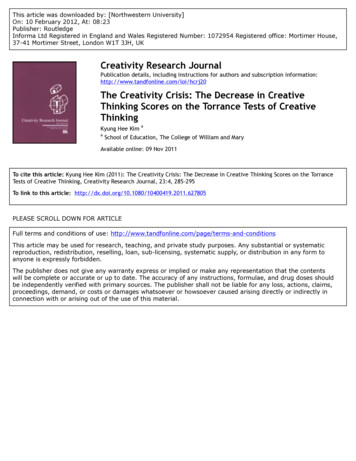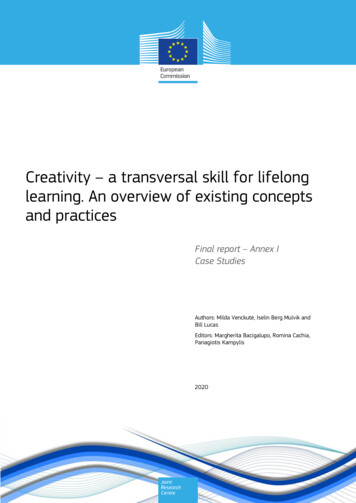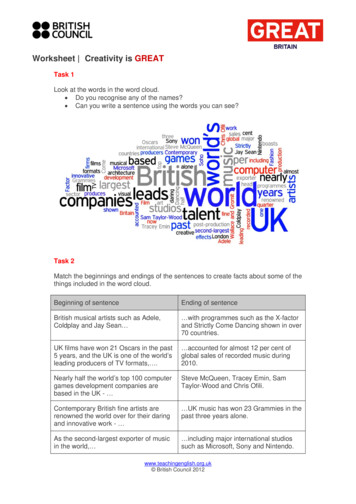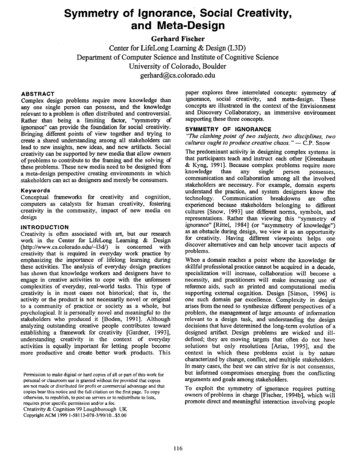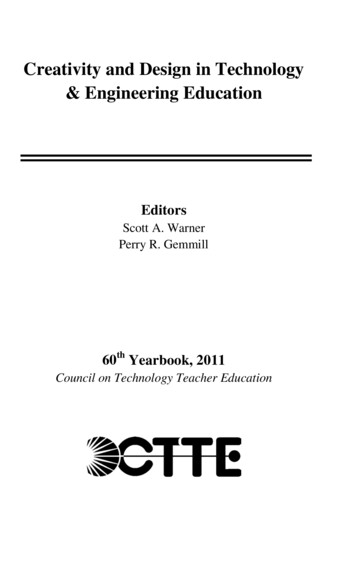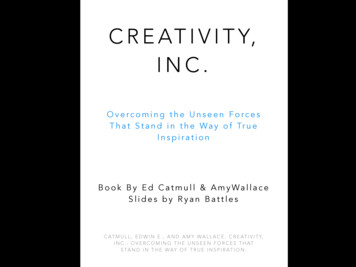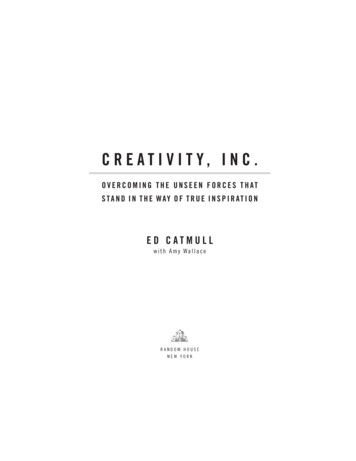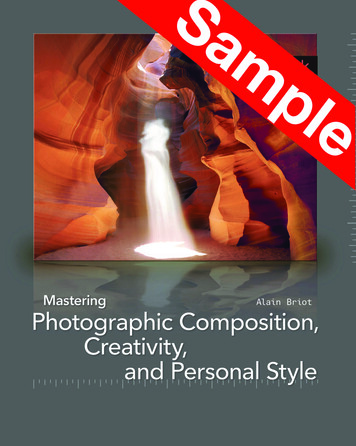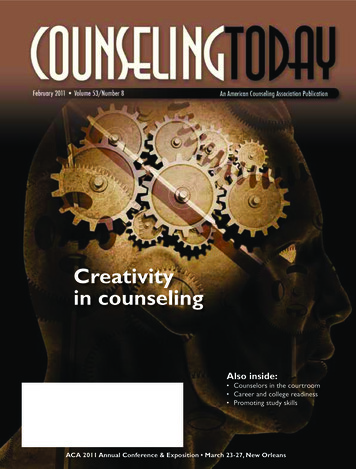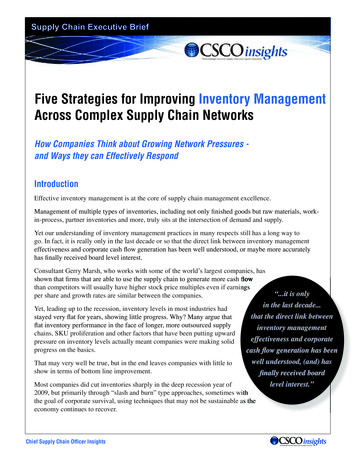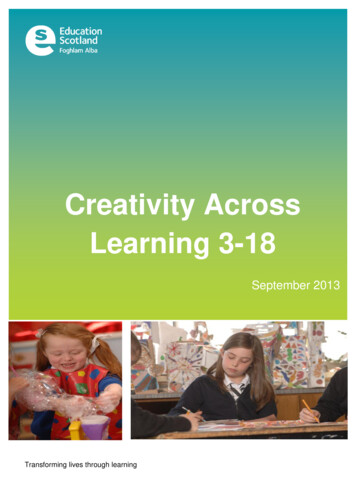
Transcription
Creativity AcrossLearning 3-18September 2013Transforming lives through learning
ForewordScotland needs to prepare its young people for life and work in an uncertaineconomic and social environment if they are to thrive in an era of increasingly rapidchange. The need for a well-developed set of higher-order skills will be a key part ofthe toolkit they will need and the ability to think creatively will be one of the mostimportant tools in that toolkit.Creativity skills are skills that are exercised in a wide variety of contexts. At its best,creativity draws on deep levels of knowledge and understanding in specific fields oflearning but takes the learner to genuinely new places. It often draws togetherknowledge and insight from diverse areas of learning, combining them in trulyinter-disciplinary ways. Creativity is very clearly at the heart of the philosophy ofCurriculum for Excellence and is fundamental to the definition of what it means to bea ‘successful learner’ in the Scottish education system.This report pulls together our developing thinking about creativity and creativity skillsand how they can most effectively be developed in educational contexts. During theinitial phase of the project, the opportunity to engage in dialogue with a wide range ofpractitioners was invaluable in helping us refine our own knowledge andunderstanding.The report also draws on stimulating dialogue with other national agencies anddelivery partners. We look forward to supporting the implementation of Scotland’sCreative Learning plan in partnership with Creative Scotland and other organisationscommitted to developing creativity in Scotland.While the findings presented here tell us that we still have some way to go in buildingconfidence and expertise in the development of creativity, it also tells us that we areworking with a rich array of opportunities and a great willingness amongstpractitioners to create and learn from each other. Many should be reassured thattheir current practices, developed within the framework of Curriculum for Excellence,provide examples that are worthy of wider dissemination for the benefit of others.In reading the report three key themes stood out particularly strongly for me. Firstly,it comes through repeatedly that a key element in enabling children and youngpeople to develop creative skills was to help them to take greater responsibility forplanning and managing their own learning. Secondly, the need to establishopen-ended approaches to learning, where learners and teachers worked together toexplore a theme, is a constant theme. Then thirdly, the potential to use externalpartnerships to broaden and enhance the learning experience is a theme which hasespecially high resonance for promoting creativity, albeit it also has relevance in allareas of learning.
Looking forward, Education Scotland is committed to continuing to work withpartners and practitioners to take forward the recommendations of the report. I hopeyou find it valuable and invite you to join with us in addressing the exciting agendafor development that it sets out.Bill MaxwellChief ExecutiveEducation Scotland
ContentsIntroduction1Context3What is Creativity?3What are creativity skills?4Why are creativity skills important for learners in Scotland?6Findings: How well are creativity skills being developed in childrenand young people?9Creativity Skills:Leadership, planning and self-evaluation9Staff understanding and confidence12The curriculum14Learning and teaching approaches22The impact on children and young people27The impact on achievement29Conclusions30Next steps for improvement in the development of creativity skills32Annex 1: Establishments which contributed to the project33Annex 2: What support is currently available for the development ofcreativity skills?34Annex 3: Creativity within Curriculum for Excellence37Annex 4: Documents used in the focus visits38Annex 5: Resources and publications45“Creativity is intelligence having fun.”Albert Einstein
IntroductionThis curriculum impact project report evaluates current practice in Scotland in thedevelopment of creativity skills in children and young people from age 3 to 18,across all curriculum areas. It proposes a definition what creativity is and identifieswhat part it plays in Scottish education. The project reflects thinking aroundCurriculum for Excellence as the broad general education becomes increasinglyembedded and the senior phase develops. It is intended that this web-based reportwill act as a hub for ongoing professional discussion and development.The project is the latest in a series designed to gauge the impact of changingpractice on learners’ experiences and achievements. It reports on successfulpartnership initiatives with one of Education Scotland’s key partners CreativeScotland, the national agency for the arts, screen and creative industries, which aimto develop creativity across learning. The curriculum impact project has harnessedthe expertise in creativity developing in local authorities through the CreativeLearning Networks. It builds on national and international research into creativity,which will continue to influence thinking within Scotland as knowledge and expertisedevelop across the world. There are many examples of research and presentationsby experts on the Creativity Portal a partnership resource jointly managed byEducation Scotland and Creative Scotland.Evidence for this project came from the following sources: A review of relevant literature to take account of key messages pertinent tocreativity. Analysis of Education Scotland inspection documents and task reports. Engagement in professional dialogue with practitioners, specialists acrossEducation Scotland and those with expertise in creativity from within andoutwith Scotland. A series of focused inspection visits to a sample of pre-school centres,primary, secondary and special schools and to one college during the periodDecember 2012 to June 2013. A list of educational establishments visited forthis project is in Annex 1.Education Scotland shared a briefing paper and the proposed topics for discussionand observation with schools and pre-school centres prior to visits. The topics usedfor discussions and classroom observation are in Annex 3 of the report. Thisenabled staff to consider our proposed definitions and to carry out informalself-evaluation in relation to their approaches to creativity. Professional dialogueabout approaches to creativity identified during these visits was enhanced byfindings from observations of learning and teaching, discussions with children andyoung people, staff and managers and where possible, local partners. The projectteam observed and discussed subject areas across the whole curriculum, with mostlessons focusing on the broad general education. Almost all the staff observed insecondary schools had volunteered for an observation because they felt that theirlessons would demonstrate aspects of creativity. Similarly, in primary schools, most1
lessons observed had an element of creative intent. The college visit focused on aspecific school, college and employer partnership project. In each of the pre-schoolcentres and special schools the project team observed a normal day in progress.The report is organised in five sections. Following the introduction, the report looksat the context for creativity. This includes exploring what creativity is, what creativityskills are, and why they are so important in Scottish education. The project hasdrawn extensively on national and international research to inform this section, andlinks and references to other publications are provided to support furtherinvestigation and study.The next section details the findings identified mainly through the focus inspectionvisits, and seeks to answer the key question: how well are creativity skills beingdeveloped in children and young people? This section looks at leadership, planningand self-evaluation; staff understanding and confidence in creativity; the curriculum;learning and teaching approaches; impact on children and young people and onachievement. This part of the report includes several case studies, which describe arange of approaches being taken across education sectors to develop creativity skillsin children and young people.Finally, the project’s conclusions are detailed, along with next steps forimprovement.Annexes provide further detail about aspects of the review. Annex 1 details theestablishments which we visited or which provided information for the project. Annex2 provides guidance about what is currently in place to support creativity inScotland, with links to the key partner organisations which are working together topromote creativity as part of Scotland’s Creative Learning Plan. Other annexesprovide further detail about creativity within Curriculum for Excellence and includedetail of the themes the project team used for classroom visits and discussions.Practitioners may find these useful to inform approaches to self-evaluation in theirown establishments.2
ContextWhat is creativity?Creativity has a high profile in Scottish education at present. It is a term thatfeatures prominently in Scottish Government policy, in Education Scotland’s valuesand in support material and literature about Curriculum for Excellence. Scotland isnot alone in exploring and focusing on creativity in education. It is also being talkedabout in other parts of the world, and there is a great deal of national andinternational research available which analyses what it is, why it is important andhow best to nurture it1.The implementation of Curriculum for Excellence across Scotland continues toinform a national view about what education is for and how best to prepare youngpeople for their future lives. Within Curriculum for Excellence creativity has aparticular role to play in providing young people with the skills to manage theuncertainty and rapid change which will inevitably feature in their lives.There are many definitions of creativity, but most have common characteristics.They focus on the analysis and identification of problems and issues, the explorationof ideas and the processes by which these ideas are realised, implemented,evaluated and refined. Following analysis of relevant literature, and for the purposesof this project, Education Scotland has defined creativity in the following way:Creativity is a process which generates ideas that have value to the individual. Itinvolves looking at familiar things with a fresh eye, examining problems with an openmind, making connections, learning from mistakes and using imagination to explorenew possibilities.Creativity is a complex concept which can impact on children and young people inmany ways. It sits at the top of the revised Bloom’s Taxonomy of Skills, as detailedwithin the Scottish Government Higher Order Skills Excellence Group report of 2011.Of course, the whole suite of higher-order skills, which include understanding,application, analysis, synthesis, evaluation, systems thinking and creation areinterdependent and not truly hierarchical. Indeed, other versions of the revisedBloom’s taxonomy are portrayed as intertwined spirals or cogs in a wheel. It is alsoemphasised within the Higher Order Skills Excellence Group report and in otherrelevant literature that all skills are based on knowledge and understanding, certainlya central tenet of creativity.This curriculum impact project draws clear distinctions between the creative process,creativity skills, creative learning and creative teaching. Though they are differentthings, there is a natural relationship between them. The project has been based onthe following definitions:1See also, for example:http://ericbooth.net/andCenters for Research on Creativity at http://www.croc-lab.org/3
A typical creative process involves investigating a problem or issue, exploringmultiple viewpoints and options, generating and testing out ideas, developing,refining and communicating solutions and evaluating whether or not they haveworked.Creativity skills are those skills which contribute to an individual’s capacity tounderstand and apply a creative process.Creative learning describes the range of activities and approaches undertakenby an individual which supports the development of creativity and other skills.Creative teaching describes approaches and activities, developed and deliveredby those who lead learning, which are usually exciting, innovative and often useunexpected techniques to engage learners. Though often associated with thedevelopment of creativity skills in learners, creative teaching approaches mightnot necessarily do this. They might for example, be used to help learners acquireknowledge and understanding effectively, rather than on the development ofcreativity skills in learners.What are creativity skills?The main focus of this project is on the development of creativity skills in childrenand young people. Within the project, the word skills encompasses attributes,capacities and dispositions, all terms which are used extensively in researchliterature. The project identifies the factors which support the development ofcreativity skills and some of the challenges which hinder it.The project highlights four key creativity skills (in bold below), and identifies the typeof attributes and learning approaches which support the development of these skills.These have been drawn from the literature available on creativity, much of which isavailable on the Creativity Portal. Our definitions reflect the language of the fourcapacities and within Building the Curriculum 3, for example: applying critical thinkingin new contexts, being open to new thinking and ideas, demonstrating anenterprising attitude, demonstrating self-reliance and thinking creatively andimaginatively. The following list aims to exemplify further the language of Curriculumfor Excellence. Although not an exhaustive list, Education Scotland proposes thatcreativity skills include being:4
constructively inquisitive, by: being curious; registering patterns and anomalies; making use of previous knowledge; researching productively; and formulating good questions.open-minded, by: using lateral thinking; using divergent thinking; hypothesising; exploring multiple viewpoints; and being flexible, adaptable and functioning well with uncertainty.able to harness imagination, by: exploring, synthesising and refining multiple options; generating and refining ideas; and inventing.able to identify and solve problems, by: understanding and defining problems; crafting, delivering and presenting solutions; demonstrating initiative, discipline, persistence and resilience; evaluating impact and success of solutions; and identifying and implementing next steps in refinement or developmentprocess.All of these do not apply all the time, but combined, and usually (though not always)in a loose sequence they form a suite of distinct skills, which support the creativeprocess described earlier in this section. Of course, creativity is a complex concept,not governed by rules, so there may be occasions when things happen in a differentorder, or as a result of moments of inspiration, or in other ways not listed above.However, while the individual elements of this suite of skills can influence manylearning situations positively, it is their combination and the consequent generationof ideas, which distinguishes creativity as a separate concept. Those familiar withdesign processes will recognise a similar concept.Unlike in other studies, collaboration is not included in this project as a key skill, butthat is not to downplay its significant contribution to creativity. Positive collaborationis critically important to the development of children and young people in general.Constructive approaches to communication, both in the generation of ideas and inrealising and evaluating them are an important aspect of the creative process.Nevertheless, the project team takes the view that collaboration is not necessarily anessential part of the creative process, and there are many examples throughouthistory, particularly in the arts, of creativity as a successful and individual pursuit.5
Why are creativity skills important for learners in Scotland?In terms of impact, the development of creativity skills should enable children andyoung people to become increasingly: motivated and ambitious for change for the better, including in their owncapabilities; confident in the validity of their own viewpoint; able to apply a creative process to other situations; and able to lead and work well with others, where appropriate.The application of creativity skills as children and young people grow and developskills for learning, life and work is particularly important. Creativity skills help childrenand young people not just to understand their world, but be sufficiently equipped toinfluence its shape and to exercise control over their interactions with it. In a climateof continuous uncertainty, change and challenge, this should enable young peopleto: interpret, anticipate and respond to developments and trends in, for example,technology, the economy, politics and social interaction; be adaptable and inventive in changing circumstances in, for example, theworkplace or through enterprise activities; challenge the status quo constructively, and generate ideas for improving it; have a sense of control over their lives; and make a positive contribution to society.Like many other countries, Scotland is reframing rapidly its economic future. Therecent economic downturn has increased attention on the need for innovation basedon high levels of knowledge and skill as the means to establishing a thrivingeconomy. It is recognised that internationally, competition will be fierce, particularlyin industries subject to rapid change and technological development. In its keydocument The Government Economic Strategy for 2013, the Scottish Governmentidentifies seven growth sectors where ‘Scotland typically has distinctive capabilitiesand businesses with the potential to be internationally successful.’ While all of thesewould benefit from creativity, innovation and inventiveness, there are three which areparticularly oriented towards it. These are energy,(including renewables), lifesciences and creative industries (including digital). It is anticipated that youngpeople leaving school today will have many different careers in their lives. This6
means they will have to be imaginative, flexible, adaptable, able to identify quicklytheir next steps and be able to implement them – all skills which sit within the realmof creativity.Many employers are looking for individuals who will be sufficiently confident to makean effective contribution to economic performance, by being able to think creativelyaround problems and have the initiative to take forward ideas. Scotland, like manycountries, recognises that it needs increased levels of entrepreneurship, but also,increasingly ‘intrapreneneurship’ where employees commit to improvingorganisational performance from within. Countries across the world, notably China,South Korea, the USA and parts of Australia have begun to recognise theimportance of creativity to future economic development and are taking steps toestablish it within their school systems.While there is a strong economic case for young people to have creativity skills,there are other arguments which support their place in education thinking.Scotland’s education system, through Curriculum for Excellence, strives to provideall learners with the means to lead fulfilling lives and make a positive contribution tosociety. There is a significant body of national and international research2 about thesocial dimension of creativity, and how the development of creativity skills helpseveryone to realise their potential, develop positive habits of mind and influencepositively all areas of their lives. In a paper entitled Researching, measuring andteaching, creativity and innovation: a strategy for the future, by Petra Mª PérezAlonso-Geta of the Institute of Creativity and Educational Innovation, University ofValencia, the human dimension of creativity is described thus:‘Human beings need to innovate and be creative within their surroundings in order tolive and progress. Creativity is a trait all human beings possess to a greater orlesser extent. Creativity is a human characteristic, archetypal of the ‘being thatponders’ that thinks, that senses the relation of cause and effect. Humans arecapable of imagining, formulating hypotheses, planning and carrying out ‘somethingnew and worthy’, establishing objectives and putting in order one’s priorities.’As well as fulfilling the very human need to explore and make new, creativity skillscan support increased empowerment, resilience, self-discipline and increasedinvolvement in society. In other words, being creative can have an impact onindividual self-esteem, wellbeing and a sense of control. This can impact positivelyon communities, cultural, sporting and environmental activities, social awareness,health and relationships. A number of international studies, many based on activitywithin the arts3, emphasise the development of generic creativity skills which lead tobetter social engagement.2See for example:Big Thought in Dallas, USA ct Zero at Harvard University, USA http://www.pz.harvard.edu/3See for example:Doing Well and Doing Good by Doing Art, James S Catterall, I-GROUPBOOKS.CO.UK, 2009The Wow Factor, Anne Bamford, WaxmannVerlag, 20067
There is also national and international support for the idea4 that developingcreativity skills helps people to learn better, whatever the subject area being studied.There are clear links between this aspect of creativity and the development of criticalthinking skills. A focus on creativity can make learning interesting, relevant, personaland engaging. It motivates people to find out more, to apply prior knowledgeproductively, analyse and synthesise information purposefully, to build confidence inpersonal efficacy, and to develop resilience. It has the potential to ‘hook’ learnersinto an engaging and unfolding learning story over which learners can exerciseinfluence. Anyone who has become deeply immersed in a creative task willrecognise the concept of creative ‘flow’, a highly rewarding state of mind whichinvolves intense concentration, a sense of deep engagement and personal agencywith a task, and an apparently seamless flow of ideas and thoughts. Creativity atthis level is the very epitome of deep learning, one of the primary aims of Curriculumfor Excellence.Everyone can develop, practise and improve creativity skills, whatever their startingpoint. While some individuals may have a stronger innate inclination towardscreativity, everyone can develop their creative capacity to an extent. A number ofstudies have attempted to define measures of creativity5 in order to monitor how wellcreativity skills are being developed, so that teachers and policy-makers can behelped to identify these skills and promote and evaluate their development.4See for example:Out of Our Minds, Ken Robinson, Capstone, 2011Unlocking Creativity, ed Robert Fisher and Mary Williams, pub David Fulton, 20105See for example:Progression in Creativity: Developing new Forms of Assessment mentNext Generation Creativity Survey Handbook: Assessing Creative Thinking, Behaviors, and Motivation in theArts, Sciences and Social Problem Thinking at http://www.croc-lab.org.uk8
FindingsHow well are creativity skills being developed in children and young people?Creativity skills: Leadership, planning and self-evaluationThere is strong agreement amongst leaders and staff across all education sectorsthat it is important to support children and young people to develop creativity skills, inorder for them to function well in the future. There is also broad agreement that thedefinition of creativity skills within this project is appropriate, with much of thelanguage already a familiar part of the learning landscape. However, while manyschool staff are familiar with the individual elements of the suite of skills, they rarely‘badge’ them as creativity, or combine them to form a distinct creative process. Thefocus visits to schools as part of this project stimulated considerable professionaldiscussion about creativity. In many instances, these discussions reduced themystique that can surround creativity as a concept and reassured practitioners thatthey were already doing many activities associated with it. Discussions also ensuredthat practitioners understood that creativity skills can be developed in all areas of thecurriculum, and not just in obvious areas, like expressive arts. Although most staffare familiar with the interrelated skills within the revised Bloom’s Taxonomy, there isgeneral agreement that understanding of the creative process and associatedcreativity skills as distinct concepts needs to be enhanced across education sectors,so that their particular characteristics can be developed for the benefit of childrenand young people.In almost all schools, Curriculum for Excellence has been a major catalyst forchange in how learning is conceived and delivered. While confidence in newapproaches is still building, most leaders and teaching staff acknowledge thatCurriculum for Excellence has provided a helpful framework within which to open upand explore different approaches to learning and to focus on the development andtracking of learners’ progress in skills. Up until the present time, there has been astrong focus on implementing the broad general education, with approaches to thesenior phase currently evolving. Very few schools have a clearly articulated strategyfor developing or monitoring creativity skills as such, but within school improvementplans, most are supporting clearly the progression of skills in enquiry, criticalthinking, learner project management and learner self-efficacy, all of which sit withinthe creativity suite. Most school leaders acknowledge the need for clearer and moreconsistent processes to help learners identify and track their own skills development,including in creativity.In many schools, enterprise initiatives have a high profile and provide a clear focusfor the development and realisation of ideas, effective collaboration andunderstanding of market forces. Initiatives like Micro-Tyco have the potential tointroduce children and young people to processes which require strong creativity, aswell as skills in research and planning. However, while many enterprise projectslead to enhanced understanding of business practices in children and young people,they do not always demand in-depth analysis of an enterprise challenge orexploration of ideas using a genuinely creative process. It is also rare for schools tohighlight to children and young people that a creative process is an intrinsic part ofenterprise projects, so they may not always make the connection. Because9
creativity is considered to be such an important part of entre- and intrapreneurship,there is a need for all education sectors to enhance their understanding of the skillsetrequired for both, ensure that learners recognise that creativity skills have a practicalapplication in their future careers.In all education sectors there is a clear demand for more guidance and practicalresources for teachers about what creativity is and how to nurture it. While mostlocal authorities provide helpful guidance and support for the development of skills ingeneral, including higher-order skills, specific guidance on developing creativity skillsis at an early stage in many local authorities. School leaders and staff would benefitfrom increased contact with their local authority’s Creative Learning Network with itspotential to support creativity or creative partnership working and build practitionerconfidence.CASE STUDY 1: LOCAL AUTHORITY SUPPORT FOR CREATIVITYCreative Conversations are City of Edinburgh’s strategic response to developing aCreative Learning Network for the city. This successful approach has been pickedup and adapted in other areas. Creative Conversations are high level discussionevents of interest to anyone involved in creativity and learning. They are heldapproximately every six weeks. The purpose is to stimulate professional dialogue,reaching a shared understanding of creativity across sectors. At the core are thefollowing ideas and questions: What do we mean by creative learning within Curriculum for Excellence?How do the arts and culture support creative learning?What are the core capacities of creativity that the arts can help develop?What are we doing to further the agenda?How do we know if learners are developing creativity skills and attributes?The overall aim of Creative Conversations is to develop creative leaders andpractitioners, contributing to improved outcomes for children and young peoplethrough the development of creativity skills. Throughout 2011/12 and 2012/13, 13Creative Conversations were attended by around 480 teachers, head/depute headteachers, managers and creative practitioners. Each Creative Conversation has adifferent Creative Catalyst in the form of influential national and international figuresand focuses on a high level theme. Discussion is about creativity and the newcurriculum. Themes have included creative approaches to self-evaluation andinspection, arts and science, technologies, flipped classroom, and the role of the artsin creativity. Discussions have considered resources available to support creativelearning, the challenges of exams and assessment and the opportunities to work inpartnership with the arts sector. All Creative Conversations have been excellentprofessional le
Annex 1 details the establishments which we visited or which provided information for the project. Annex 2 provides guidance about what is currently in place to support creativity in Scotland, with links to the key partner organisations which are working together to promote creativity as part of Scotland
